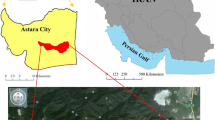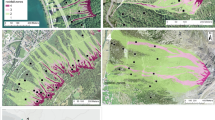Abstract
This study aims at identifying forest areas affected by surface erosion in Catalonia. It analyses the characteristics of forests that are related to erosion occurrence. The data on erosion observations and stand variables were obtained from the Third Spanish National Forest Inventory (2000–2001). We used the classification tree method to study the presence–absence of surface erosion in four different forest types, pure coniferous, pure broadleaf and mixed stands as well in forested semiarid areas. The method provided a description of the site and stand variables, which are associated with the occurrence of surface erosion. The results revealed that forest type and stand structure are strongly related to the probability of surface erosion occurrence. In pure broadleaf forests, surface erosion occurrence was greater in dense stands, whereas in pure coniferous pine forest, the erosion occurrence was greater in sparse stands. Surface erosion occurrence was the highest in stands dominated by Fagus sylvatica and Abies alba. In order to estimate the erosion probabilities of stands, we converted the results of the classification tree analysis into erosion probabilities and mapped forest areas as low, moderate or high surface erosion risk. The accuracy of the erosion probabilities was assessed using the ROC curve, which gave a fair level (0.75) of accuracy for the total classification tree, the best (0.78) for pure broadleaf and the lowest (0.66) for mixed forest. The results of this study can be applied in future forest management planning aiming to reduce erosion risk in forests.






Similar content being viewed by others
References
Barbier S, Balandier P, Gosselin F (2009) Influence of several tree traits on rainfall partitioning in temperate and boreal forest: a review. Ann For Sci 66:602
BDN (2001) Mapa Forestal de España. MFE50 Escala 1:50 000 Cataluña: Lerida, Gerona, Barcelona, Tarragona. Organismo Autónomo Parques Nacionales, Madrid
Berg B, McClaugherty C (2008) Plant litter–decomposition, humus formation, carbon sequestration, 2nd edn. Springer, Heidelberg
Blanco H, Lal R (2008) Principles of soil conservation and management. Springer, Netherlands
Brandt J (1987) The effect of different types of forest management on the transformation of rainfall energy by the canopy in relation to soil erosion. In: Proceedings of the forest hydrology watershed management conference Vancouver, BC (1987), IAHS Publication No. 167, pp 213–222
Breiman L (1996) Bagging predictors. Mach Learn 24:123–140
Breiman L, Friedman JH, Olshen RA, Stone CJ (1984) Classification and regression trees. Wadsworth International Group, Belmont
Brooks SM, Spencer T (1995) Vegetation modification of rainfall characteristics Implication for rainfall erositivity following logging in Sabah, Malaysia. J Trop For Sci 7(3):435–446
Calder IR (2001) Canopy processes: implications for transpiration, interception and splash induced erosion, ultimately for forest management and water resources. Plant Ecol 153:203–214
Casas MC, Herrero M, Ninyerola M, Pons X, Rodríguez R, Rius A, Redaño A (2007) Analysis and objective mapping of extreme daily rainfall in Catalonia. Int J Climatol 27:399–409
Clavero P, Martín Vide J, Raso JM (1997) Atles climàtic de Catalunya (ACC). Institut Cartogràfic de Catalunya i Departament de Medi Ambient, Generalitat de Catalunya, Barcelona
Coll L, González-Olabarria JR, Mola-Yudego B, Pukkala T, Messier C (2011) Predicting understory maximum shrubs cover using altitude and overstory basal area in different Mediterranean forest. Eur J For Res 130:55–65
Cook EF, Goldman L (1984) Empiric comparison of multivariate analytic techniques: advantages and disadvantages of recursive portioning. J Chronic Dis 37:721–731
Costa M, Morla C, Sainz H (2005) Los Bosques Ibéricos–Una interpretación geobotánica, 4th edn. Editorial planeta, Barcelona
Covert SA, Robinchaud PR, Elliot WJ, Link TE (2005) Evaluation of runoff prediction from WEPP-based erosion models for harvesting and burned forest watershed. Trans ASAE 48(3):1091–1100
DeBano LF (2000) The role of fire and soil heating on water repellency in wildland environments: a review. J Hydrol 231–232:195–206
DGCN (2001) Tercer Inventario Forestal Nacional (1997–2006) Cataluña. Ministerio de Medio Ambiente, Madrid
DGCN (2002) Plan Forestal Español 2002–2032. Ministerio de Medio Ambiente. Dirección General de Conservación de la Naturaleza, Madrid
DGCN (2004) Inventario nacional erosión suelos. Barcelona, Ministerio de Medio Ambiente, Madrid
Dissmeyer G, Foster GR (1980) A guide for predicting sheet and rill erosion on forest land. Technical publication. USDA Forest Service, Atlanta
Dun S, Wu JQ, Elliot WJ, Robichaud PR, Flanagan DC, Frankenberger JR, Brown RE, Xu AC (2009) Adapting the water erosion prediction project (WEPP) model for forest application. J Hydrol 366:46–54
Edeso JM, Merino A, González MJ, Mapauri P (1999) Soil erosion under different harvesting managements in steep forestlands from Northern Spain. Land Degrad Dev 10:79–88
Elliot WJ, Robichaud PR (2001) Comparing erosion risks from forest operations to wildfire. Proceedings of the 2001 International Mountain Logging and 11th Pacific Northwest Skyline Symposium, Seattle, Washington. University of Washington, Seattle
Elliot WJ, Hall DE, Graves SR (1999) Predicting sedimentation from forest roads. J For 97(8):23–29
FAO (2006) World reference base for soil resources 2006—a framework for international classification, correlation and communication. World Soil Resources Reports 103, Rome
Fernández S, Marquínez J, Menéndez Duarte R (2005) A susceptibility model for post wildfire soil erosion in a temperate oceanic mountain area of Spain. Catena 61:256–272
Ferri C, Flach P, Hernández-Orallo J (2003) Decision trees for ranking: effect of new smoothing methods, new splitting criteria and simple pruning methods. Technical report, DSIC, UPV
Flanagan DC, Livingston SJ (1995) Water erosion prediction project (WEPP) version 95.7 user summary. West Lafayette, IN. NSERL Report No. 11. USDA-ARS National Soil Erosion Research Laboratory, West Lafayette, Ind
Gómez-Gutiérrez A, Schnabel S, Lavado-Contador JF (2009) Using and comparing two nonparametric methods (CART and MARS) to model the potential distribution of gullies. Ecol Model 220:3630–3637
González JR, Pukkala T (2007) Characterization of forest fires in Catalonia (north-east Spain). Eur J of For Res 126:421–429
González-Hidalgo JC, Peña-Monne JL, de Luis M (2007) A review of daily soil erosion in Western Mediterranean areas. Catena 71:193–199
González-Olabarria JR, Pukkala T (2011) Integrating fire risk considerations in landscape level forest planning. For Ecol Manag 261:278–287
Gracia C, Burriel JA, Ibáñez JJ, Mata T, Vayreda J (2004) Inventari Ecologic i Forestal de Catalunya. CREAF, Catalunya
Grimm M, Jones R, Montanarella L (2002) Soil erosion risk in europe. EUR 19939 EN, European soil bureau. Institute for environment & sustainability. JRC Ispra, Italy
Han J, Kamber M (2001) Data mining: concepts and techniques. Morgan Kaufmann, San Francisco
Hosmer DW, Lemeshow S (2000) Applied logistic regression, 2nd edn. Wiley, New York
ICONA (1991) Plan Nacional de lucha contra la erosión. Ministerio de Agricultura, pesca y alimentación. Instituto Nacional para la conservación de la naturaleza, Madrid
Jones C (2001) RUSLE applications on Arizona rangelands. Arizona Ranchers’ Management guide. Rangeland Manag 73–78
Kang W, Deng X, Zhao Z (2008) Effects of canopy interception on energy conversion processes in a Chinese fir plantation ecosystem. Front For China 3:264–270
Karr JR, Dudley DR (1981) Ecological perspective on water quality goals. Environ Manag 5:55–68
Laflen JM, Elliot WJ, Flanagan DC, Meyer CR, Nearing MA (1997) WEPP-predicting water erosion using a process based model. J Soil Water Conserv 52:96–102
Lal R (2003) Soil erosion and the global carbon budget. Environ Int 29:437–450
Lana X, Burgueño A (1998) Spatial and temporal characterization of annual extreme droughts in Catalonia (Northeast Spain). Int J Climatol 18:93–110
Merlo M, Croitoru L (2005) Valuing Mediterranean forest: towards total economic value. CABI Publishing, Wallingford
Morgan RPC (2005) Soil erosion and conservation, 3rd edn. Blackwell, Oxford
Morgan RPC, Quinton JN, Smith RE, Govers G, Poesen JWA, Auerswald K, Chisci G, Torri D, Styczen ME (1998) The European soil erosion model (EUROSEM): a dynamic approach for predicting sediment transport from fields and small catchments. Earth Surf Process Landf 23:527–544
Morris GL, Fan J (1998) Reservoir sedimentation handbook–design and management of dams, reservoirs and watersheds for sustainable use. McGraw-Hill, New York
Ninyerola M, Pons X, Roure JM (2000) A methodological approach of climatological modelling of air temperature and precipitation through GIS techniques. Int J Climatol 20:1823–1841
Palahi M, Mavsar R, Gracia C, Birot Y (2008) Mediterranean forest under focus. Int For Rev 10:676–688
Pierson FB, Robichaud PR, Moffet CA, Spaeth KE, Williams CJ, Hardegree SP, Clark PE (2008) Soil water repellency and infiltration in coarse-textured soils of burned and unburned sagebrush ecosystems. Catena 74:98–108
Planchais I, Sinoquet H (1998) Foliage determinants of light interception in sunny and shaded branches of Fagus sylvatica (L.). Agric For Met 89:241–253
Provost F, Domingos P (2003) Tree induction for probability based ranking. Mach Learn 52(3):199–215
Razafindrabe BHN, He B, Inoue S, Ezaki T, Shaw R (2010) The role of stand density in controlling soil erosion: implication to sediment – related disasters in Japan. Environ Monit Assess 160:337–354
Renard KG, Foster GR, Weessies GA, McCool DK, Yoder DC (1997) Predicting soil erosion by water: a guide to conservation planning with the Revised Universal Soil Loss Equation (RUSLE). US Department of Agriculture, Agriculture Handbook 703
Rouget M, Richardson DM, Lavorel S, Vayreda J, Gracia C, Milton SJ (2001) Determinants of distribution of six pinus species in Catalonia, Spain. J Veg Sci 12:491–502
Sayer E (2006) Using experimental manipulation to assess the roles of leaf litter in the functioning of forest ecosystems. Biol Rev 81:1–31
Scarascia-Mugnozza G, Oswald H, Piussi P, Radoglou K (2000) Forest of the Mediterranean region: gaps in knowledge and research needs. For Ecol Manag 132:97–109
Sesnie SE, Gessler PE, Finegan B, Thessler S (2008) Integrating Landsat TM and SRTM-DEM derived variables with decision trees for habitat classification and change detection in complex neotropical environments. Remote Sens Environ 112(5):2145–2159
Soil Atlas of Europe (2006) 1 km Raster version of the European soil database (v. 2.0). In: Marc Van Liedekerke, Arwyn Jones, Panos Panagos (eds) European Soil Bureau Network & European Commission, EUR 19945 EN
Spaeth K, Pierson FB, Weltz MA, Blackburn WH (2003) Evaluation of USLE and RUSLE estimated soil loss on rangeland. J Range Manag 56:234–246
Therneau TM, Atkinson EJ (1997) An introduction to recursive partitioning using the RPART routines. Technical Report 61, Mayo Clinic, Section of Statistics
Thornthwaite CW (1948) An approach toward a rational classification of climate. Geogr Rev 38:55–94
Thuiller W, Vayreda J, Pino J, Sabate S, Lavorel S, Gracia C (2003) Large-scale environmental correlates of forest tree distribution in Catalonia (NE Spain). Global Ecol Biogeogr 12:313–325
Tóth N, Pataki B (2007) On classification confidence and ranking using decision trees. In: Proceedings of 11th international conference on intelligent engineering systems, pp 133–138
Trabaud L (1994) Post-fire plant community dynamics in the Mediterranean Basin. In: Moreno JM, Oechel WC (eds) ‘The role of fire in the Mediterranean-Type ecosystems. Ecological studies, Springer, New York, pp 1–15
Vayssiéres MP, Plant RE, Allen-Diaz BH (2000) Classification trees: an alternative non-parametric approach for predicting species distribution. J Veg Sci 11:679–694
Wischmeier WH, Smith DP (1978) Predicting rainfall erosion losses–a guide for selection for conservation planning. Agricultural Handbook (US Dept of Agriculture) 537
Zhang H, Wang Q, Dai L, Guofan S, Tang L, Wang S, Gu H (2006) Quantifying soil erosion with GIS-based RUSLE under different forest management options in Jianchang forest farm. Sci China E Technol Sci 49(Supp. 1):160–166
Acknowledgments
We thank the Centre Tecnològic Forestal de Catalunya for providing the part of the necessary data and the Graduate School in Forest Sciences for the financial support of this study. Our special thanks to Dr Blas Mola Yudego for his valuable contribution to the manuscript.
Author information
Authors and Affiliations
Corresponding author
Additional information
Communicated by A. Merino.
Rights and permissions
About this article
Cite this article
Selkimäki, M., González-Olabarria, J.R. & Pukkala, T. Site and stand characteristics related to surface erosion occurrence in forests of Catalonia (Spain). Eur J Forest Res 131, 727–738 (2012). https://doi.org/10.1007/s10342-011-0545-x
Received:
Revised:
Accepted:
Published:
Issue Date:
DOI: https://doi.org/10.1007/s10342-011-0545-x




